An Optimal Domestic Electric Vehicle Charging Strategy for Reducing Network Transmission Loss While Taking Seasonal Factors into Consideration
Abstract
:1. Introduction
- (1)
- Key factors (users’ driving habits, users’ preference of charging vehicles, and ambient temperature, etc.) that can affect domestic users’ charging behavior have been fully analyzed when modelling a domestic electric vehicle charging loads model. It is worth noting that for the first time in the context of domestic electric vehicles, seasonal factors are considered to model the electrical charging loads of a single domestic electric vehicle.
- (2)
- It is the first time that the exponential distribution is used to model the domestic users’ daily travelling distance, and compared with the logarithmic normal distribution, the exponential distribution model is more suitable and accurate to reveal domestic users’ daily travelling distance.
- (3)
- The 0-1 integer programming method is proposed to regulate electric vehicle charging loads and reduce distributed power system transmission loss. By introducing binary states to domestic electric vehicle charging loads, calculation complexity can be significantly reduced, which makes the proposed strategy more real-world feasible.
2. Domestic Electric Vehicle Charging Loads Modelling
2.1. Users’ Driving Habits and Preference of Charging Electric Vehicles
2.2. Ambient Temperature
2.3. Domestic Users’ Electric Vehicle Charging Loads Modelling
3. Electric Vehicle Charging Loads Control Strategy and the Transmission Loss Optimization
3.1. 0-1 Integer Programming for Regulating Electric Vehicle Charging Loads
3.2. The Transmission Loss Optimization
4. Case Study
5. Results and Analysis
5.1. Charging Electric Vehicle without Any Optimal Strategy
5.2. Charging Electric Vehicle with the Proposed Optimal Strategy
5.3. The Transmission Loss Optimization Results
6. Conclusions
Acknowledgments
Author Contributions
Conflicts of Interest
References
- Abdul-Manan, A.F.N. Uncertainty and differences in GHG emissions between electric and conventional gasoline vehicles with implications for transport policy making. Energy Policy 2015, 87, 1–7. [Google Scholar] [CrossRef]
- Clement-Nyns, K.; Haesen, E.; Driesen, J. The impact of vehicle-to-grid on the distribution grid. Electr. Power Syst. Res. 2011, 81, 185–192. [Google Scholar] [CrossRef]
- Clement-Nyns, K.; Haesen, E.; Driesen, J. The Impact of Charging Plug-In Hybrid Electric Vehicles on a Residential Distribution Grid. IEEE Trans. Power Syst. 2010, 25, 371–380. [Google Scholar] [CrossRef] [Green Version]
- Hadley, S.W.; Tsvetkova, A.A. Potential Impacts of Plug-in Hybrid Electric Vehicles on Regional Power Generation. Electr. J. 2009, 22, 56–68. [Google Scholar] [CrossRef]
- Qian, K.; Zhou, C.; Allan, M.; Yuan, Y. Modeling of Load Demand Due to EV Battery Charging in Distribution Systems. IEEE Trans. Power Syst. 2011, 26, 802–810. [Google Scholar] [CrossRef]
- Brady, J.; O’Mahony, M. Modelling charging profiles of electric vehicles based on real-world electric vehicle charging data. Sustain. Cities Soc. 2016, 26, 203–216. [Google Scholar] [CrossRef]
- Li, G.; Zhang, X.P. Modeling of Plug-in Hybrid Electric Vehicle Charging Demand in Probabilistic Power Flow Calculations. IEEE Trans. Smart Grid 2012, 3, 492–499. [Google Scholar] [CrossRef]
- Cheng, L.; Chang, Y.; Liu, M.; Wu, Q. Estimating EV integration patterns considering spatial dispersion in distribution systems. In Proceedings of the 2015 IEEE Power & Energy Society General Meeting, Denver, CO, USA, 26–30 July 2015; pp. 1–5. [Google Scholar]
- Yin, Z.; Che, Y.; Li, D.; Liu, H.; Yu, D. Optimal Scheduling Strategy for Domestic Electric Water Heaters Based on the Temperature State Priority List. Energies 2017, 10, 1425. [Google Scholar] [CrossRef]
- Tehrani, N.H.; Wang, P. Probabilistic estimation of plug-in electric vehicles charging load profile. Electr. Power Syst. Res. 2015, 124, 133–143. [Google Scholar] [CrossRef]
- Usman, M.; Knapen, L.; Yasar, A.U.H.; Bellemans, T.; Janssens, D.; Wets, G. Optimal recharging framework and simulation for electric vehicle fleet. Future Gener. Comput. Syst. 2017. [Google Scholar] [CrossRef]
- Luo, X.; Chan, K.W. Real-time scheduling of electric vehicles charging in low-voltage residential distribution systems to minimise power losses and improve voltage profile. IET Gener. Transm. Distrib. 2014, 8, 516–529. [Google Scholar] [CrossRef]
- Esmaili, M.; Rajabi, M. Optimal charging of plug-in electric vehicles observing power grid constraints. IET Gener. Transm. Distrib. 2014, 8, 583–590. [Google Scholar] [CrossRef]
- Clement, K.; Haesen, E.; Driesen, J. Coordinated charging of multiple plug-in hybrid electric vehicles in residential distribution grids. In Proceedings of the Power Systems Conference and Exposition (PSCE ’09), Seattle, WA, USA, 15–18 March 2009; pp. 1–7. [Google Scholar]
- Deilami, S.; Masoum, A.S.; Moses, P.S.; Masoum, M.A.S. Real-Time Coordination of Plug-In Electric Vehicle Charging in Smart Grids to Minimize Power Losses and Improve Voltage Profile. IEEE Trans. Smart Grid 2011, 2, 456–467. [Google Scholar] [CrossRef]
- Ali, A.; Raisz, D.; Mahmoud, K. Sensitivity-based and optimization-based methods for mitigating voltage fluctuation and rise in the presence of PV and PHEVs. Int. Trans. Electr. Energy Syst. 2017, 27, e2456. [Google Scholar] [CrossRef]
- Bakır, M.A.; Aksop, C. A 0–1 integer programming approach to a university timetabling problem. Hacettepe Univ. Bull. Nat. Sci. Eng. 2008, 37, 41–55. [Google Scholar]
- U.S. Department of Transportation F.H.D. National Household Travel Survey. 2009. Available online: http://nhts.ornl.gov/download.shtml (accessed on 25 October 2017).
- Shojaei, S.; McGordon, A.; Robinson, S.; Macro, J. Improving the Performance Attributes of Plug-in Hybrid Electric Vehicles in Hot Climates through Key-off Battery Cooling. Energies 2017, 10, 2058. [Google Scholar] [CrossRef]
- Chang, D. Study on Short Term Load Forecasting Model of Electric Vehicle Charging Station in Smart Grid; Qingdao University: Qingdao, China, 2015. [Google Scholar]
- Abdalrahman, A.; Zhuang, W. A Survey on PEV Charging Infrastructure: Impact Assessment and Planning. Energies 2017, 10, 1650. [Google Scholar] [CrossRef]
- Ding, H.; Hu, Z.; Song, Y. Value of the energy storage system in an electric bus fast charging station. Appl. Energy 2015, 157, 630–639. [Google Scholar] [CrossRef]
- Rubino, L.; Capasso, C.; Veneri, O. Review on plug-in electric vehicle charging architectures integrated with distributed energy sources for sustainable mobility. Appl. Energy 2017, 207, 439–464. [Google Scholar] [CrossRef]
- Nienhueser, I.A.; Qiu, Y. Economic and environmental impacts of providing renewable energy for electric vehicle charging—A choice experiment study. Appl. Energy 2016, 180, 256–268. [Google Scholar] [CrossRef]
- Yu, D.; Liu, H.; Yan, G.; Jiang, J.; Le Blond, S. Optimization of Hybrid Energy Storage Systems at the Building Level with Combined Heat and Power Generation. Energies 2017, 10, 606. [Google Scholar] [CrossRef]
- Zhu, X. Short-Term Load Forecasting and Its Application System of Power System; Southeast University: Dhaka, Bangladesh, 2004. [Google Scholar]
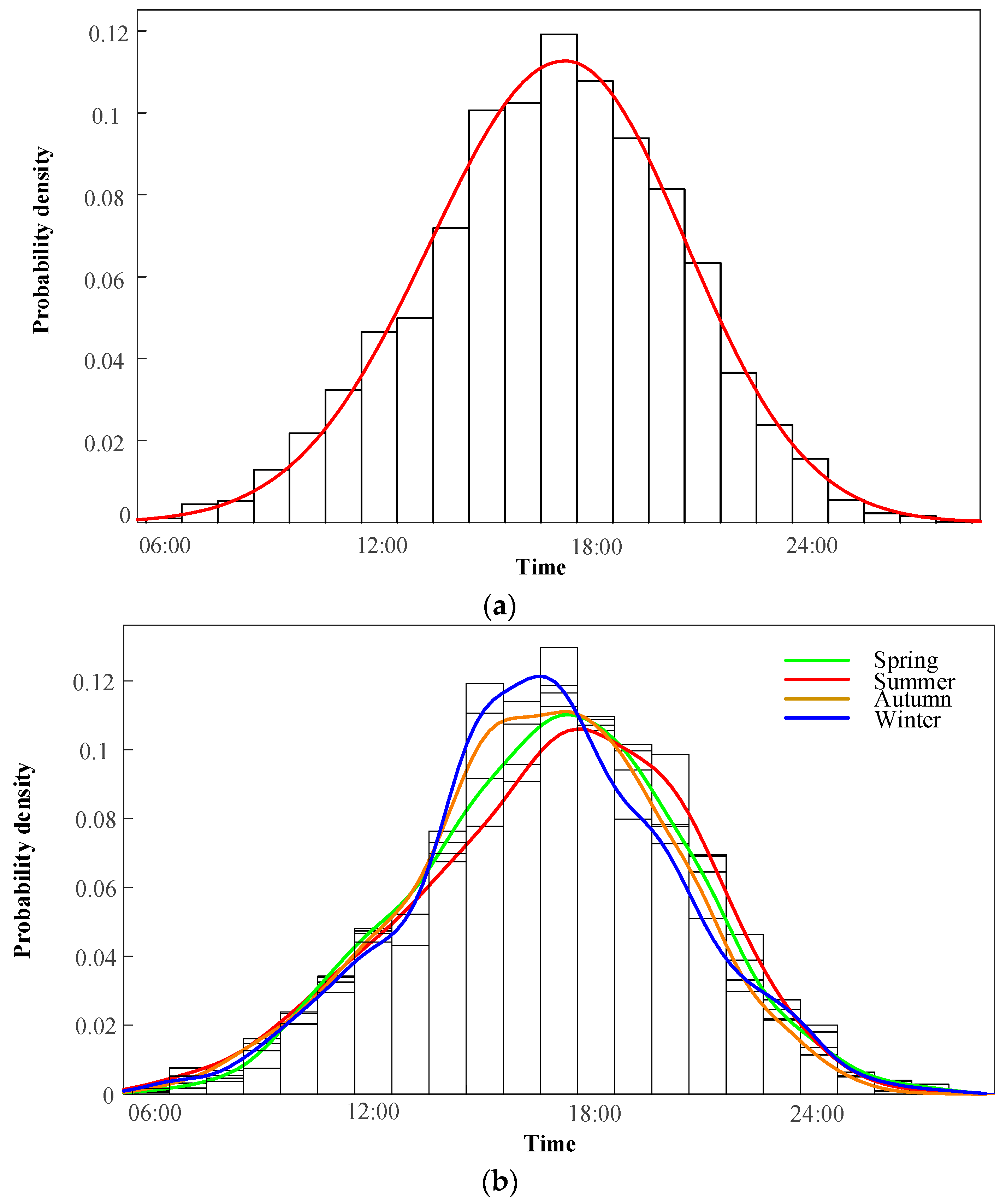
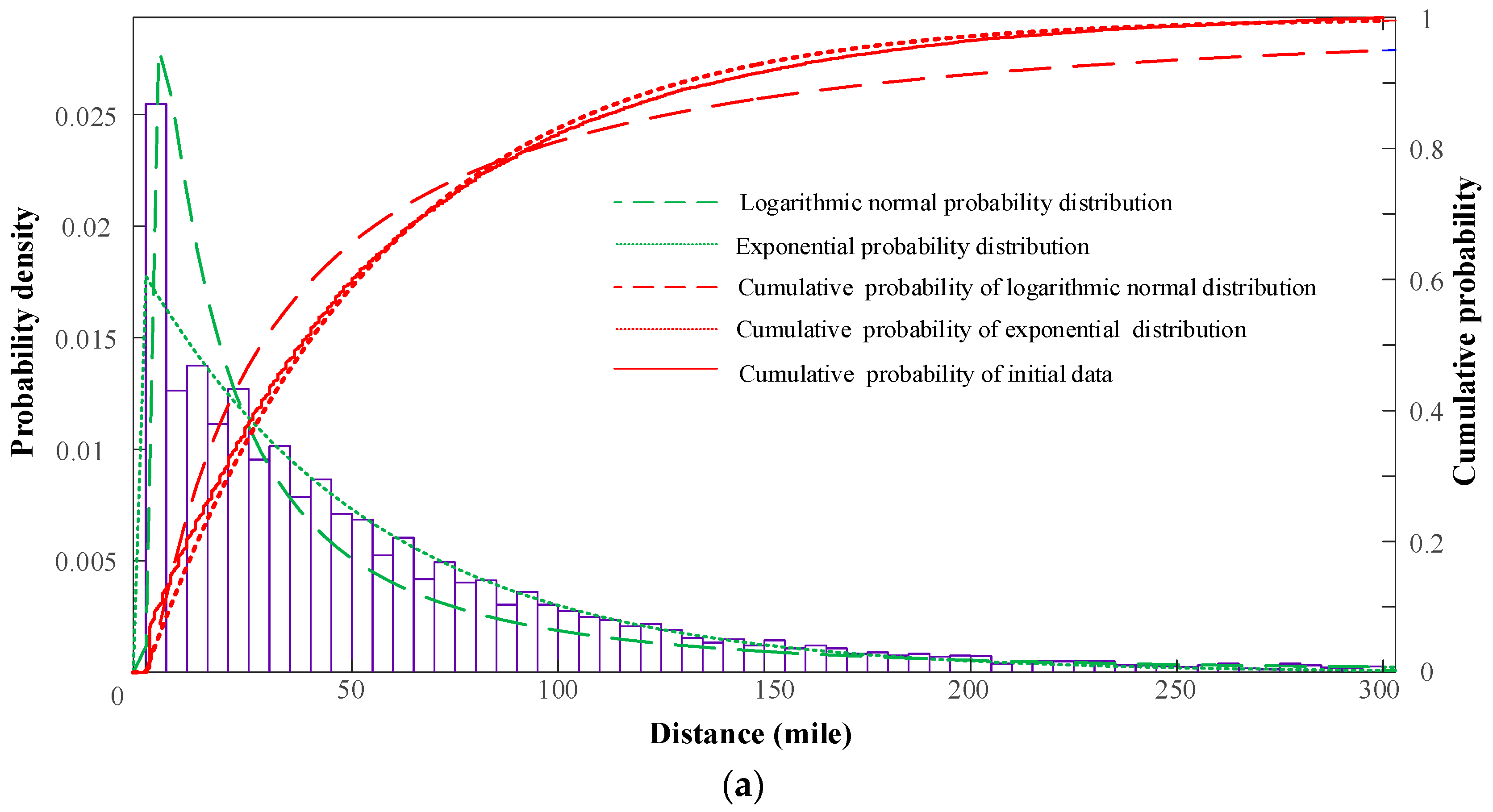

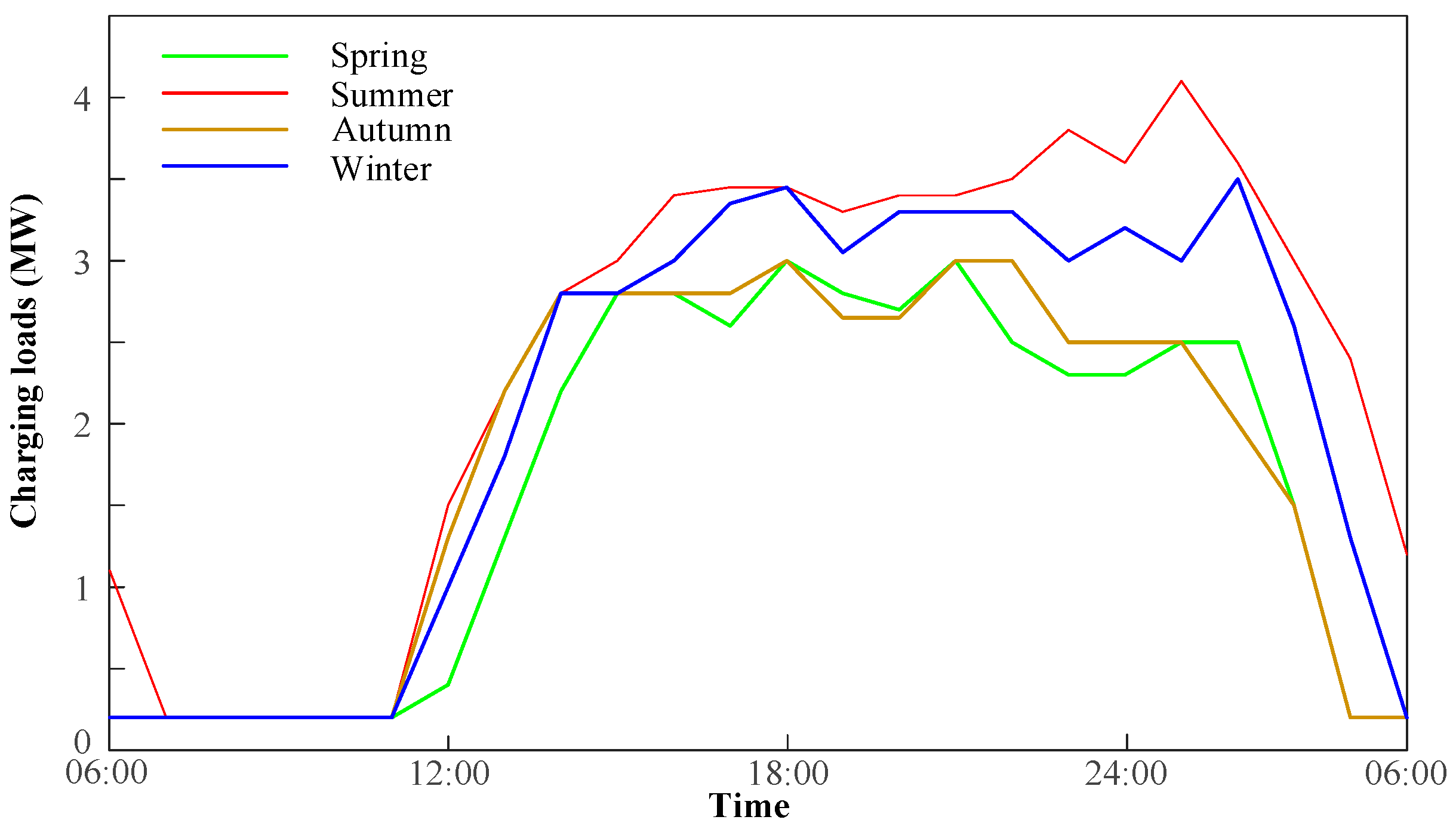
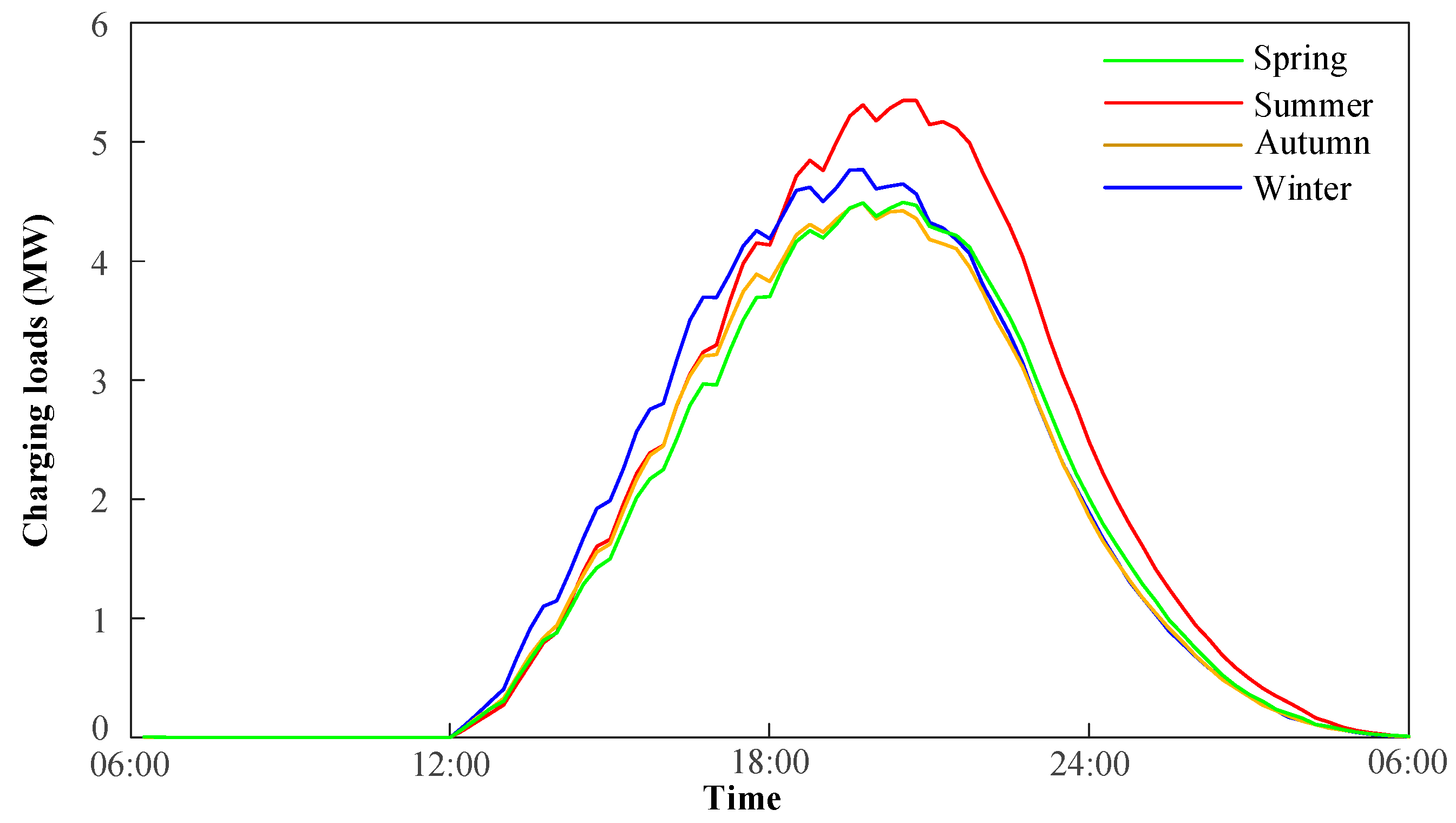
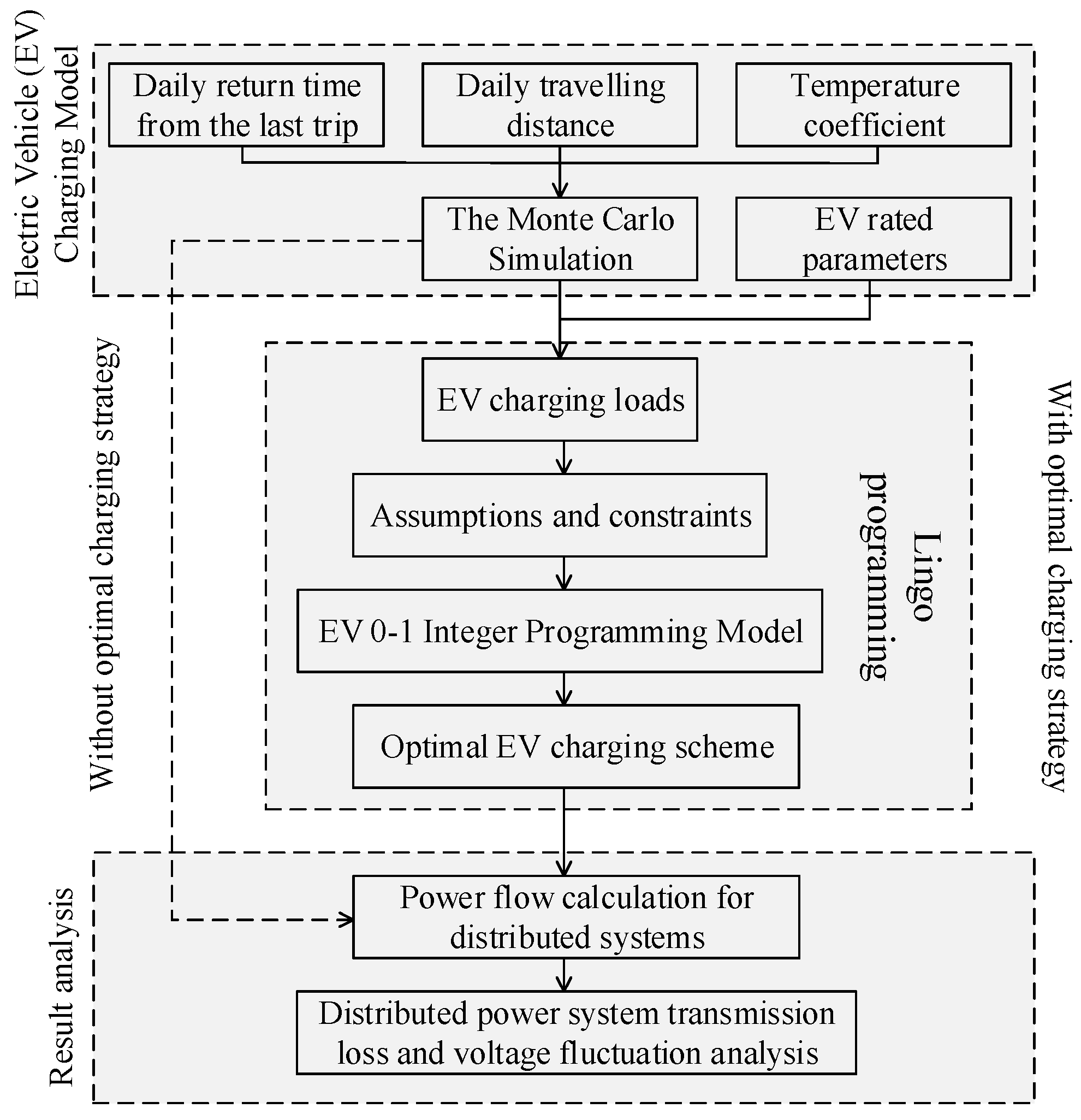

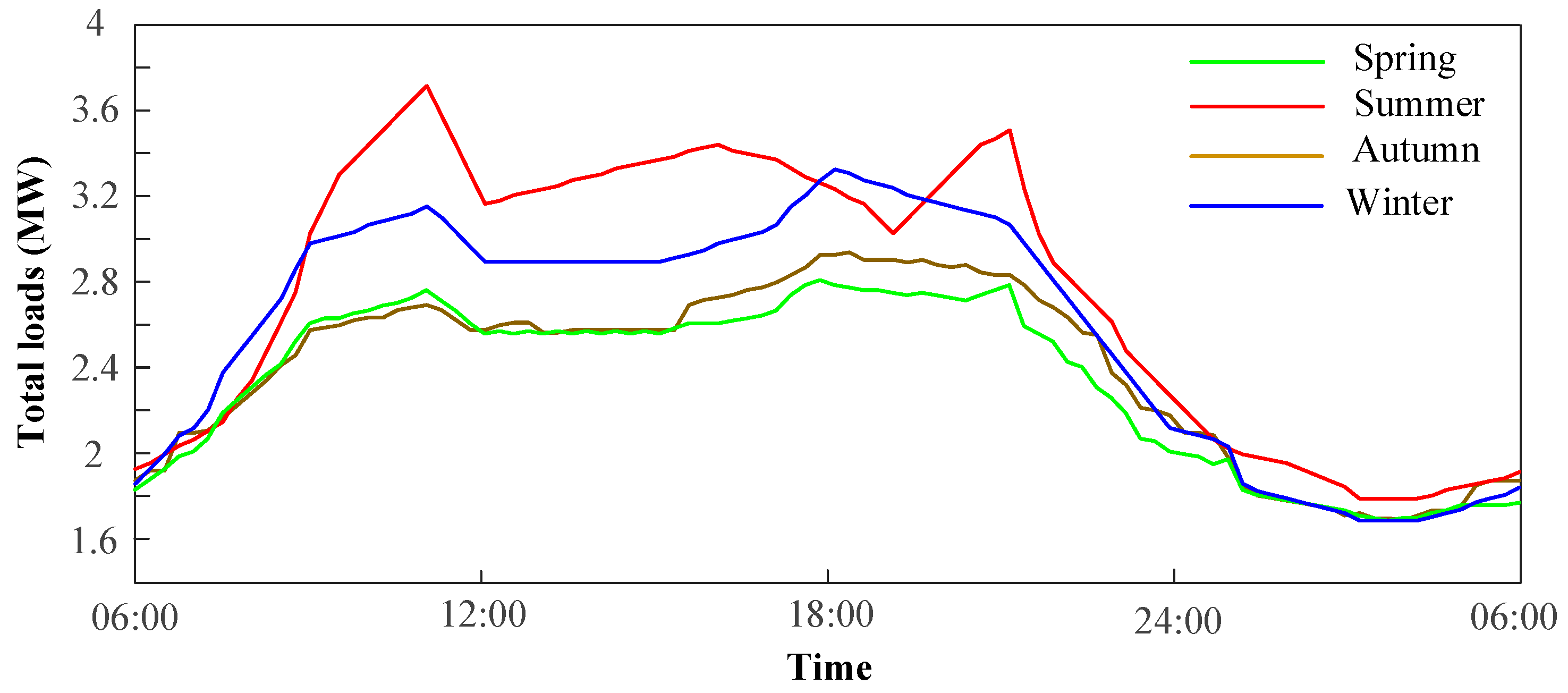
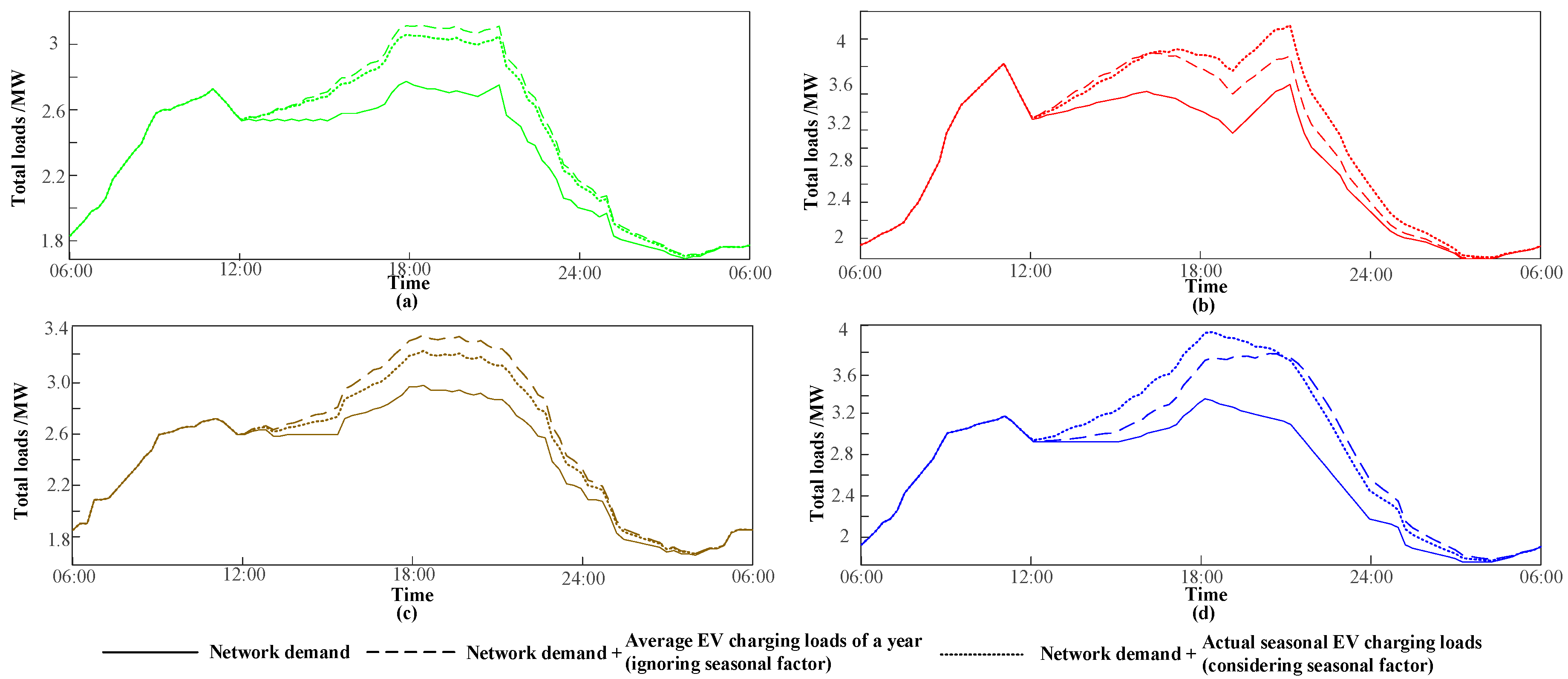

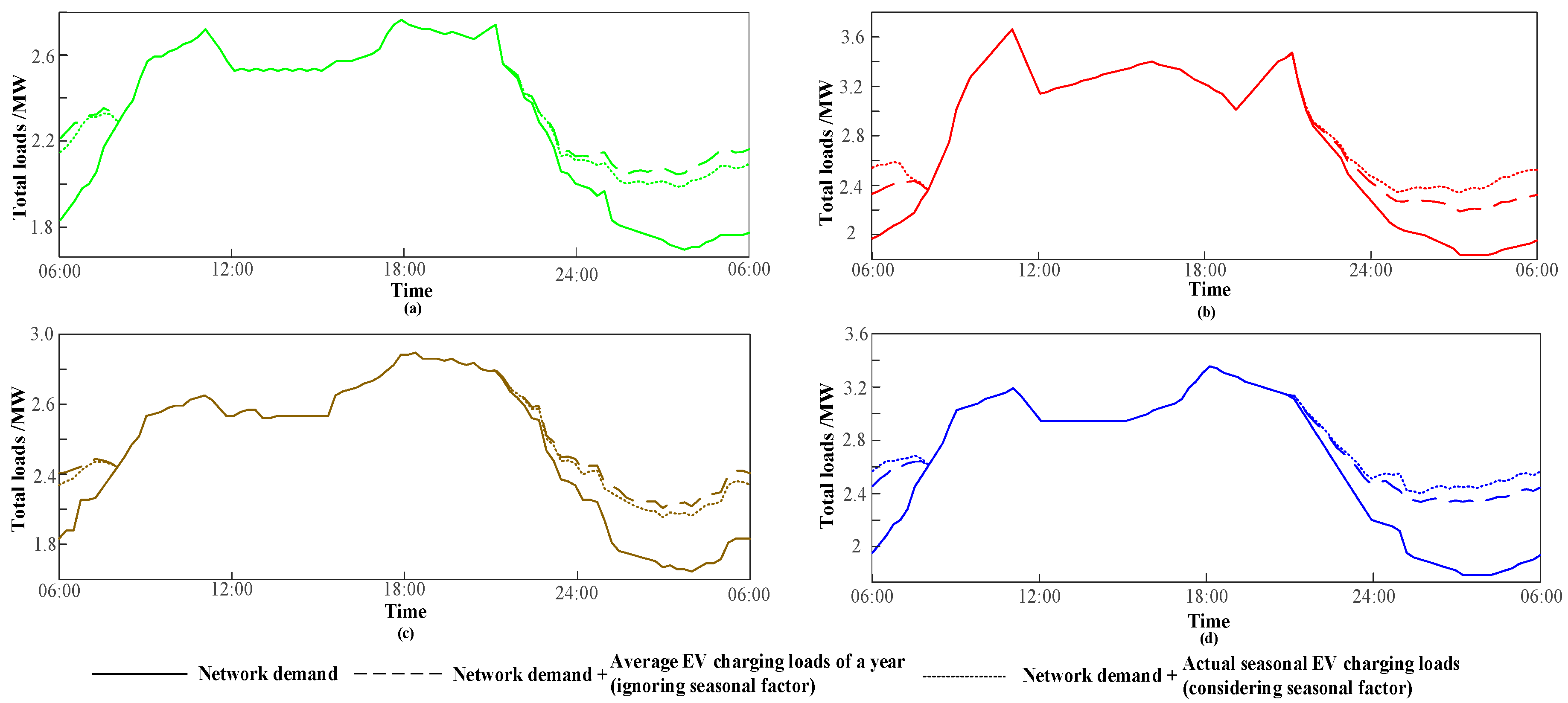
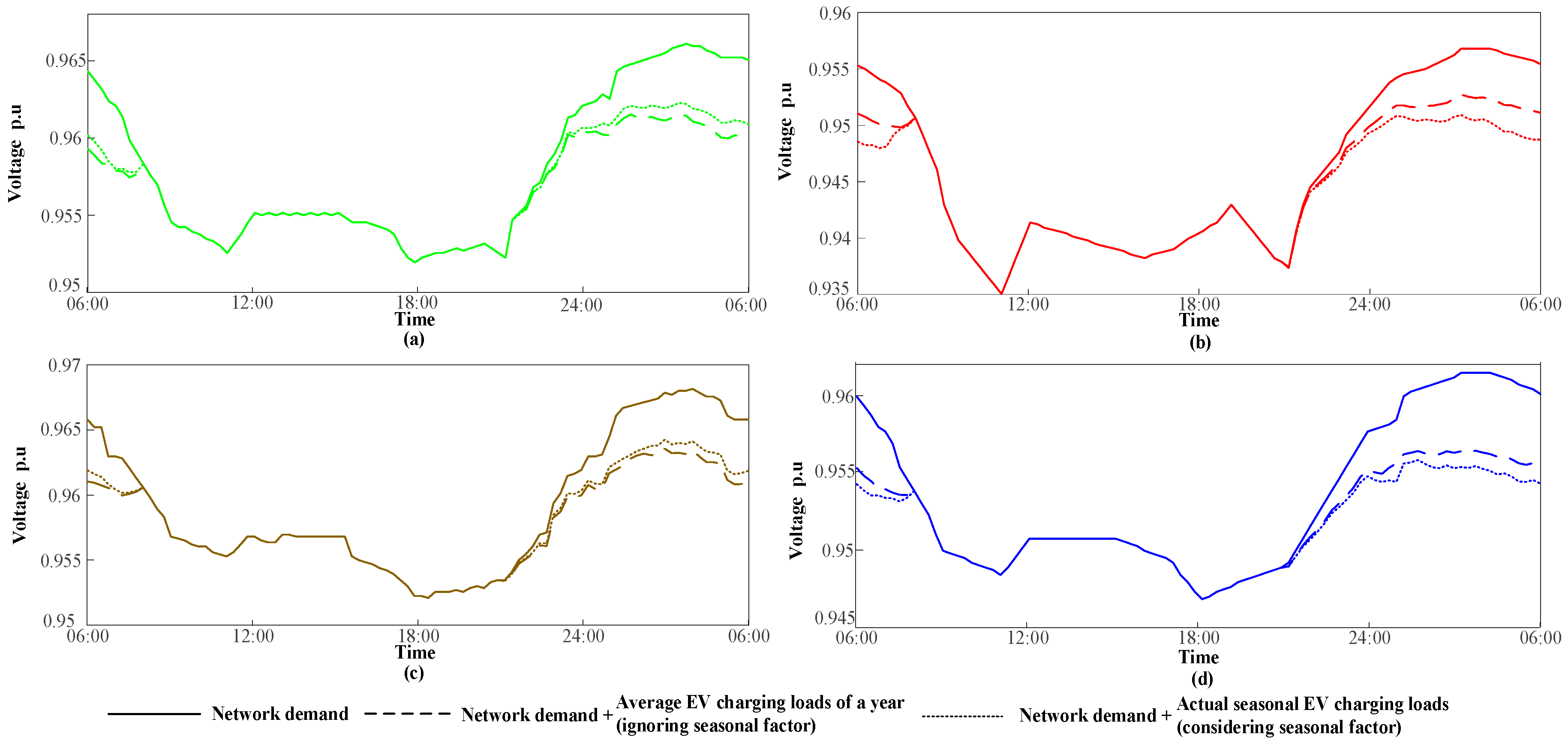
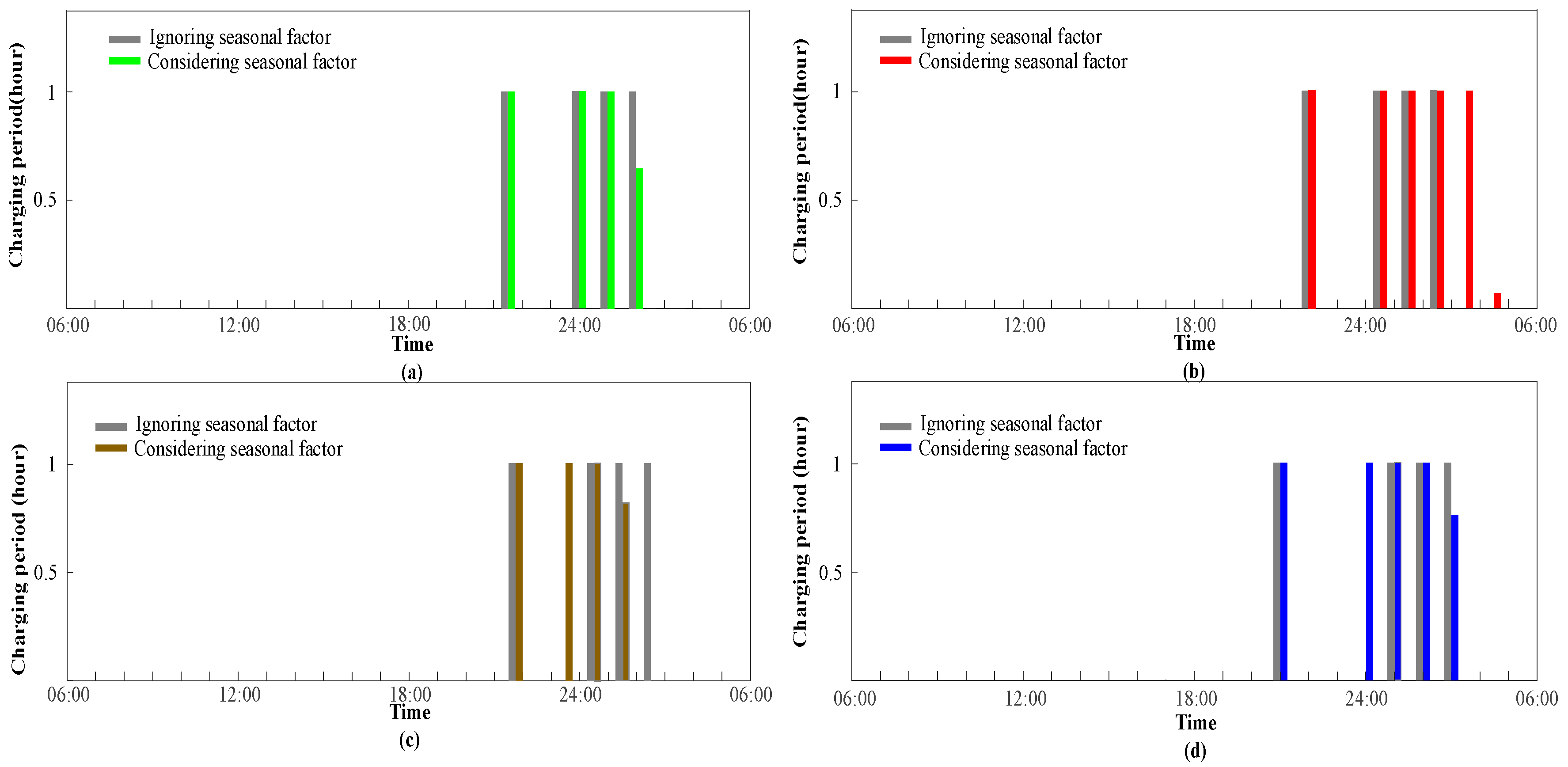
| Parameters | Spring | Summer | Autumn | Winter |
|---|---|---|---|---|
| μend | 17:48 1 | 18:00 1 | 17:26 1 | 17:10 1 |
| σend | 3.60 | 3.59 | 3.60 | 3.62 |
| Standardized Charging Loads | Spring | Summer | Autumn | Winter |
|---|---|---|---|---|
| Standardized Maximum Charging Loads | 1 | 1.37 | 1.07 | 1.23 |
| Standardized Average Charging Loads | 1 | 1.30 | 1.03 | 1.19 |
| Seasons and Cases | Daily Network Demands (MW·h) | Network Loss (MW·h) | Loss Rate (%) | |
|---|---|---|---|---|
| Spring | Case 1 1 | 57.61 | 1.66 | 2.88 |
| Case 2 1 | 59.94 | 1.96 | 3.27 | |
| Case 3 1 | 59.94 | 1.86 | 3.10 | |
| Case 4 1 | 59.94 | 1.88 | 3.14 | |
| Summer | Case 1 1 | 75.10 | 2.85 | 3.79 |
| Case 2 1 | 78.13 | 3.25 | 4.16 | |
| Case 3 1 | 78.13 | 3.05 | 3.90 | |
| Case 4 1 | 78.13 | 3.12 | 3.99 | |
| Autumn | Case 1 1 | 58.08 | 1.69 | 2.91 |
| Case 2 1 | 60.48 | 1.99 | 3.29 | |
| Case 3 1 | 60.48 | 1.89 | 3.13 | |
| Case 4 1 | 60.48 | 1.90 | 3.14 | |
| Winter | Case 1 1 | 65.31 | 2.18 | 3.34 |
| Case 2 1 | 68.04 | 2.63 | 3.87 | |
| Case 3 1 | 68.04 | 2.50 | 3.67 | |
| Case 4 1 | 68.04 | 2.54 | 3.73 | |
© 2018 by the authors. Licensee MDPI, Basel, Switzerland. This article is an open access article distributed under the terms and conditions of the Creative Commons Attribution (CC BY) license (http://creativecommons.org/licenses/by/4.0/).
Share and Cite
Zhao, Y.; Che, Y.; Wang, D.; Liu, H.; Shi, K.; Yu, D. An Optimal Domestic Electric Vehicle Charging Strategy for Reducing Network Transmission Loss While Taking Seasonal Factors into Consideration. Appl. Sci. 2018, 8, 191. https://doi.org/10.3390/app8020191
Zhao Y, Che Y, Wang D, Liu H, Shi K, Yu D. An Optimal Domestic Electric Vehicle Charging Strategy for Reducing Network Transmission Loss While Taking Seasonal Factors into Consideration. Applied Sciences. 2018; 8(2):191. https://doi.org/10.3390/app8020191
Chicago/Turabian StyleZhao, Yuancheng, Yanbo Che, Dianmeng Wang, Huanan Liu, Kun Shi, and Dongmin Yu. 2018. "An Optimal Domestic Electric Vehicle Charging Strategy for Reducing Network Transmission Loss While Taking Seasonal Factors into Consideration" Applied Sciences 8, no. 2: 191. https://doi.org/10.3390/app8020191





